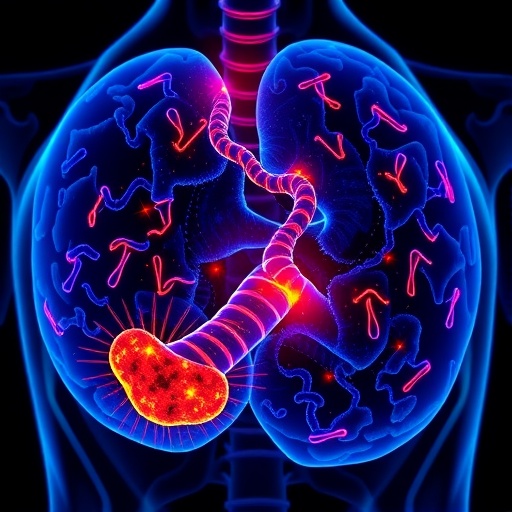Prostate cancer remains a formidable challenge in the landscape of male health, standing as one of the most diagnosed malignancies across the globe. While early-stage prostate cancer often benefits from established curative treatments with encouraging outcomes, advanced prostate cancer continues to evade effective management. Traditional therapeutic strategies, including androgen deprivation therapy (ADT), salvage radiotherapy, and systemic chemotherapy, frequently fall short in halting disease progression or achieving long-term remission in advanced cases. The urgent clinical call to action is directed towards the discovery of novel molecular targets that could revolutionize treatment paradigms and enhance patient survival.
Recent investigations have turned the spotlight on the glutathione S-transferase mu 3 (GSTM3) enzyme, illuminating its intriguing role in the biological dynamics of advanced prostate cancer. GSTM3, classically recognized for its role in detoxification processes and maintaining cellular redox balance, has now been implicated in modulating cancer progression. This emerging evidence positions GSTM3 not only as a biomarker for prostate cancer aggression but also as a promising target for therapeutic intervention.
In a comprehensive study published in BMC Cancer, researchers analyzed GSTM3 expression across a spectrum of prostate cancer models. By leveraging public transcriptomic databases such as GEO and UALCAN, they identified a marked overexpression of GSTM3 in advanced prostate cancer samples. This trend was further validated experimentally using prostate cancer cell lines, including DU-145 and PC-3, as well as three-dimensional tumorsphere cultures that better mimic tumor microenvironments. Remarkably, tumorspheres demonstrated even higher levels of GSTM3, pointing to its potential involvement in tumor initiation and maintenance mechanisms.
To unravel the functional consequences of elevated GSTM3, the researchers employed RNA interference techniques to silence GSTM3 expression in prostate cancer cells. This targeted knockdown approach facilitated a detailed exploration of GSTM3’s influence on key cellular processes. Subsequent assays revealed a complex modulation of intracellular redox status, with silenced cells exhibiting a paradoxical increase in mitochondrial membrane potential (mtMP) alongside a modest reduction in reactive oxygen species (ROS) levels. These findings suggest that GSTM3 contributes to the delicate equilibrium of mitochondrial function and oxidative stress in cancer cells, with potential repercussions for cell survival and proliferation.
Beyond redox regulation, GSTM3 depletion profoundly affected cell cycle progression. Flow cytometric analysis showed a significant arrest at the G0/G1 phase, indicating that GSTM3 may facilitate cell cycle transition and sustained tumor growth. The consequence of this arrest cascaded into enhanced cell death mechanisms, with a notable rise in necrotic cell populations and a modest increase in programmed apoptosis. This dual mode of cell demise hints at a critical dependency of advanced prostate cancer cells on GSTM3 activity for evading lethal stress and maintaining proliferative capacity.
From a therapeutic standpoint, these discoveries open compelling avenues for designing GSTM3-centric treatment strategies. Given its overexpression in aggressive prostate cancer and its regulatory role in key survival pathways, GSTM3 inhibition could synergize with existing therapies to overcome resistance mechanisms. Targeted downregulation of GSTM3 might sensitize tumor cells to chemotherapeutic agents or induce vulnerability to oxidative damage, thereby amplifying treatment efficacy.
The study’s integration of multi-dimensional data—from bioinformatics repositories to in vitro functional assays—provides robust validation of GSTM3 as a critical molecular node in prostate cancer pathobiology. Importantly, the enhanced expression of GSTM3 within tumorspheres underscores its potential involvement in cancer stem cell biology, a domain often linked to tumor relapse and metastasis. Therapeutic intervention targeting GSTM3 could thus impact the aggressive subpopulations driving disease progression.
Future research is primed to elucidate the precise molecular circuits orchestrated by GSTM3, including its downstream targets and interaction with redox-sensitive signaling cascades. Detailed mechanistic insights will be crucial for the rational design of small molecule inhibitors or RNA-based therapeutics aimed at GSTM3. Moreover, translational studies assessing the efficacy and safety of such interventions in preclinical prostate cancer models will pave the way for clinical application.
This innovative focus on GSTM3 aligns with a broader strategy to exploit the cancer cell’s metabolic and oxidative vulnerabilities. By disrupting detoxification enzymes that facilitate tumor cell survival under oxidative stress, researchers can push cancer cells beyond their adaptive thresholds, promoting therapeutic cytotoxicity. GSTM3 emerges as a linchpin in this paradigm, integrating metabolic homeostasis with cell cycle control and death regulation.
Collectively, the affirmation of GSTM3’s oncogenic role reinforces the narrative that advanced prostate cancer necessitates a multi-faceted therapeutic approach. Targeting GSTM3 could shift the current treatment paradigm beyond hormone-based therapies and cytotoxic agents, addressing the molecular underpinnings that sustain tumor resilience and adaptation.
The implications of these findings extend into precision oncology, where monitoring GSTM3 expression levels might serve as a prognostic or predictive biomarker. Stratifying patients based on GSTM3 activity could individualize therapeutic regimens, optimizing clinical outcomes and minimizing adverse effects.
In conclusion, this groundbreaking research spearheaded by Seven, Dalan, and Bayrak spotlights GSTM3 as a viable and compelling candidate for advancing prostate cancer treatment. Their meticulous integration of bioinformatics and experimental validation charts a promising path toward novel, effective therapies. By targeting GSTM3, the oncology community moves closer to overcoming the formidable challenge of advanced prostate cancer, offering hope to patients confronting this relentless disease.
Subject of Research: Glutathione S-transferase mu 3 (GSTM3) in advanced prostate cancer and its potential as a therapeutic target
Article Title: Targeting GSTM3 for therapeutic potential in advanced prostate cancer
Article References:
Seven, D., Dalan, A.B. & Bayrak, Ö.F. Targeting GSTM3 for therapeutic potential in advanced prostate cancer.
BMC Cancer 25, 1493 (2025). https://doi.org/10.1186/s12885-025-14946-8
Image Credits: Scienmag.com
DOI: https://doi.org/10.1186/s12885-025-14946-8




